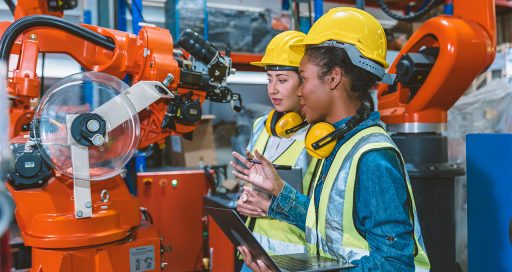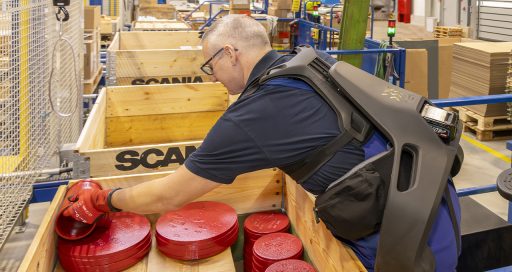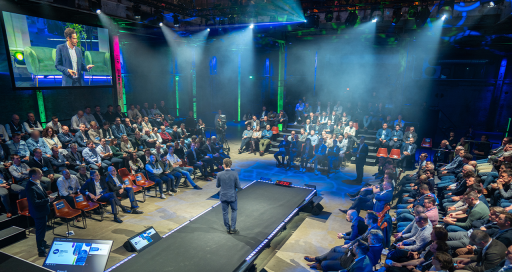Re-industrialisation and industrial sovereignty are key elements in recovery plans in most developed economies. The development of robotisation is a powerful factor in this global movement.

In an increasingly competitive economic context, productivity and agility remain key to industrial expansion worldwide. And robotisation has long been seen as a major factor in the sector’s transformation. It offers numerous benefits: increased competitiveness, greater flexibility in production, enhanced quality, improved safety and working conditions, and reduced environmental impacts.
“There is a correlation between industrial growth and modern production facilities,” says Vincent Bouffard, Deputy CEO of VINCI Energies France.
Technological advances
In recent years, technological advances have made the conditions for increasing robotisation more favourable than ever. “The boom in cloud computing and mobile networks has helped to optimise robotic performance in an increasingly digitalised production context,” explains Jade Le Maître, CEO at Proxinnov, a cluster for promoting and developing France’s industrial robotics sector.
“Alongside which,” she adds, “the creation of new interfaces and the increasing use of low-code and no-code development have considerably simplified programming. Add to that the expansion of artificial intelligence and better-performing equipment, such as vision solutions, which have made automation more accessible.”
The curse of PoC
This alignment of the technological spheres comes at a time when the industrial sector needs to recognise and address the labour shortages in developed countries, in particular for essential tasks such as welding, assembly and handling. Also, production post-COVID is undergoing a profound change with the new challenge of relocalisation or “nearshoring”, which involves relocating an activity to another region in the same or a nearby country.
However, according to studies carried out by the research consultants Gartner and Roland Berger, only around 30% of companies worldwide have implemented relevant robotics solutions throughout their organisations.
In areas such as connectivity, data, AI, and indeed AI-enhanced robotics, an overwhelming majority of businesses see these innovations as essential to their growth, but considerably fewer have actually launched related demonstrators or proofs of concept (PoCs), and fewer still (barely a quarter) have deployed these trial solutions at scale.
“To break the curse of PoC, a stage that many businesses struggle to move on from,” says the Proxinnov CEO, “it is essential to follow some basic rules: define the organisation’s vision, following a clear, phased roadmap and remaining focused on the commercial benefits rather than the technology; identify the technologies that meet operational needs and create an ecosystem of strategic partners committed to the long term; and last but not least, involve teams at every level of the business by encouraging the development of skills through training and by supporting the change process.”
Asia leading the way
Despite all this, increasing numbers of businesses seem to be taking the plunge. According to the World Robotics 2022 – Industrial Robots report published by the International Federation of Robotics, the number of collaborative robots installed worldwide between 2021 and 2022 increased by 31% (517,000 new units), predominantly in handling, with welding and assembly lagging well behind.
This upswing associated directly with the post-COVID period was mostly driven by Asian countries, which account for 74% of all robots installed, with China alone responsible for 52%. Jade Le Maître emphasises that “This strong growth in the global robotic fleet is primarily due to government support, which is vital for robotics.”
“There is a correlation between industrial growth and modern production facilities.”
China has invested US$1.7 trillion in its Made in China 2025 strategic plan, which launched in 2015 with the aim of increasing national robotics capacities through massive investment in R&D, infrastructure and the development of talent, with appreciable results (see box).
Similarly, early in 2024, South Korea announced a US$2.24 billion investment in its fourth national robotics plan, which includes substantial tax breaks, massive support for R&D and startups, and a target of 1 million robots deployed in industry by 2030. Germany, Italy, the United States and France have also invested considerable resources in developing the robotics sector.
SMEs on the front line
In terms of business sectors, logistics is one of the most advanced and dynamic (see section below). But all sectors face common challenges in their automation and robotisation, such as providing resilient local supply chains, ensuring technological sovereignty, and creating a pool of qualified and highly skilled workers.
Small and medium-sized enterprises are on the front line of robotisation. “SMEs are the new targets for the democratisation of robotics,” says Jade Le Maître, who sees this as “a vast and as-yet untapped market in which cobots [collaborative robots that interact directly with human operators] have a particularly important role to play.”
To illustrate the potential of SMEs, Joan Guasch, International Development Director at EURECAT, the Catalan technology centre, cites the example of the French programme Robot Start PME.
Created by Symop (the French professional union of industrial solution creators), Cetim (the technical centre for the mechanical industries) and CEA‑List (the CEA technical research institutes dedicated to intelligent digital systems), this programme helped around a hundred industrial SMEs modernise their production bases between 2013 and 2017.
For Joan Guasch, “Robot Start PME played a fundamental role in promoting the use of robots in small and medium-sized enterprises. Thanks to robotisation, SMEs have increased their net earnings by 55% and created 5% new jobs, while stimulating innovation.” QED.
China – and the rest
The range of public policies dedicated to promoting robotics in industry varies between countries, and the figures reflect this: in 2022, China installed more than 290,000 robots, considerably ahead of Japan, which installed more than 50,000 robots, and which in proportion to the size of its production apparatus, remains the world’s most robotised nation, ahead of the United States (just under 40,000), South Korea (over 30,000), Germany (25,000), Italy (11,000), Taiwan (almost 8,000) and France (7,500). Note that in 2023, the number of industrial robots installed in France fell by 18.4%, with 6,022 robots installed according to the robotics group Evolis
Recycled robots
At its Roche sur Yon site in Vendée, western France, Proxinnov, the technological resource centre dedicated to robotics, has 13 robotic cells offering a wide range of applications: cobotics, palletisation, logistics, welding, handling, inspection, machining, etc. One of its priorities is the re-use of robots.
“For a long time, automated cells were linked to a single product,” Proxinnov CEO Jade Le Maître tells trade magazine L’Usine Nouvelle. “Afterwards, the line was discarded. But the great thing about robots is their versatility and the possibility of re-using them, which is an important factor in being competitive.” Robot manufacturer Kuka, a Proxinnov partner, guarantees that “40% to 100% of their robots can be recycled.”
Logistics: the sector ahead of the game
The logistics sector is one of the most advanced in terms of robotisation, having taken on board the benefits and also the challenges it presents.
“Robotics brings numerous benefits, not least improved workplace safety, improved efficiency and productivity, greater scalability, and the ability to operate 24/7,” says Ralf W. Buerk, Senior Group Manager Operations Supplier Coordination at Geopost, a La Poste Group subsidiary and service provider.
“A robotics rollout must nevertheless factor in certain constraints,” he adds, highlighting CapEx [the investment spending required], TCO [Total Cost of Ownership, i.e. the total cost of an asset over its entire life cycle] and maintenance costs, “but above all, the speed, and therefore the productivity from technological upgrades to machines; their integration with existing systems; and data security, with cybersecurity the crucial issue.”
While the logistics sector is far ahead of many others, third-party logistics in particular, which outsources company supply chains, still has considerable room for improvement in terms of robotisation.
In 2023, 60% to 80% of logistics warehouses worldwide had few or no automated systems. It seems that firms in the sector are still discouraged by the cost – between US$5 and 15 million to equip a typical warehouse.
Prospects in this market are therefore considerable. Robotics for product picking and transportation alone will be worth US$1.34 billion by 2025, and the worldwide market for exoskeletons is expected to be worth close to US$3.7 billion by 2028.
“Robotisation offers undeniable opportunities in business terms,” says Olivier Storch, Deputy CEO Finance and Transformation at CEVA Logistics (CMA CGM Group) which specialises in outsourced logistics, “but it is important to keep track of your [financial] depreciation, especially given the speed with which technology evolves, and factor in staff training.”
10/17/2024





